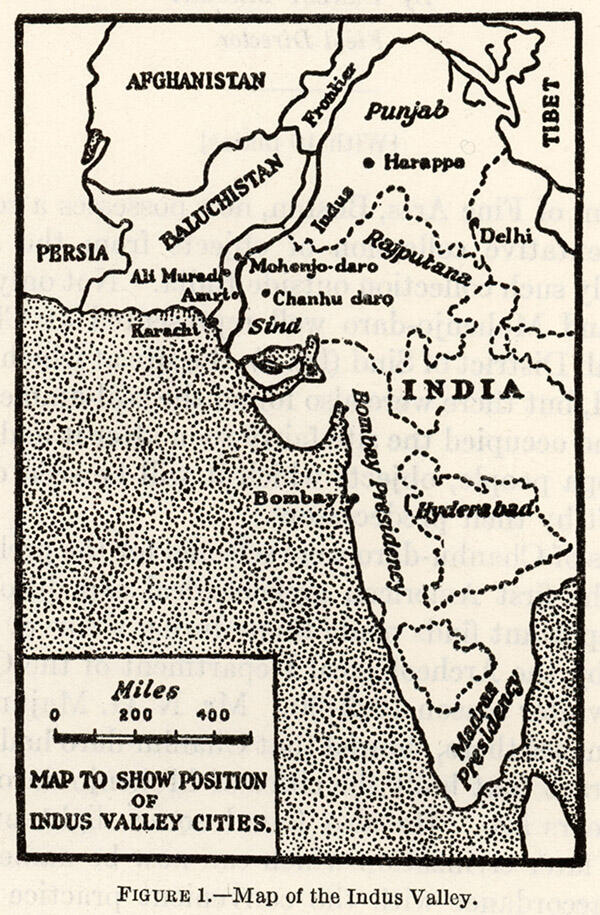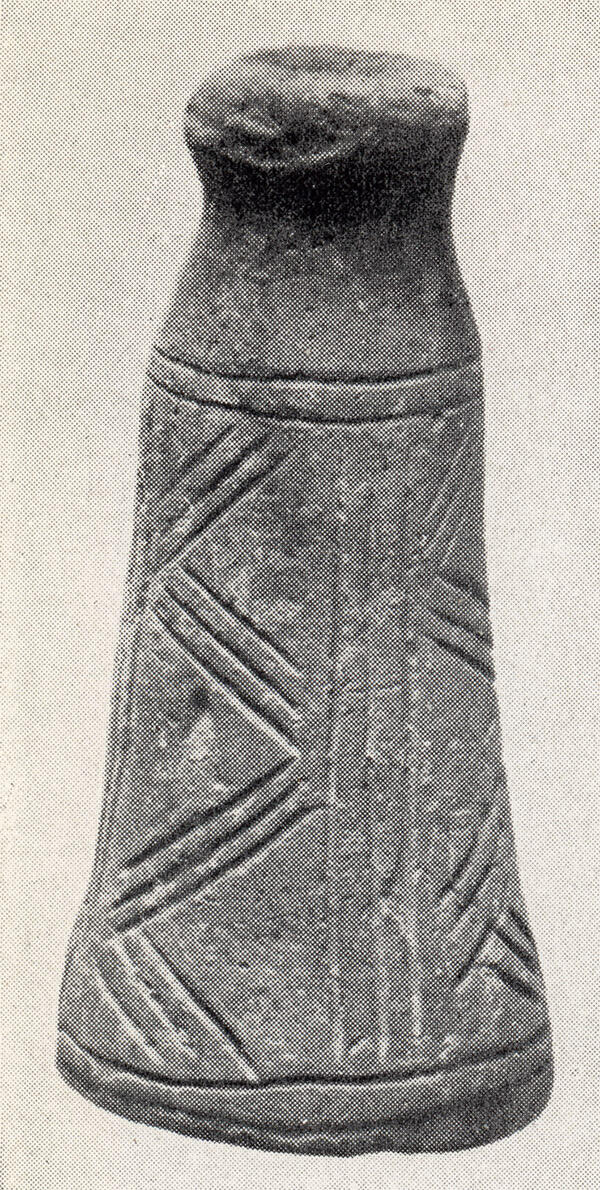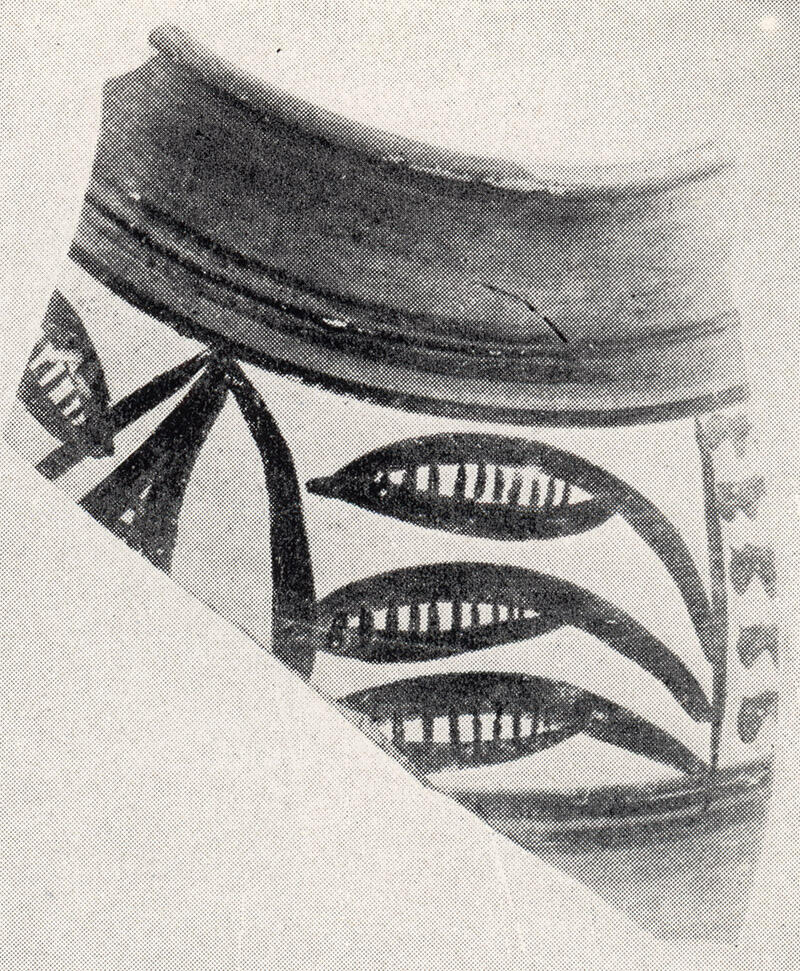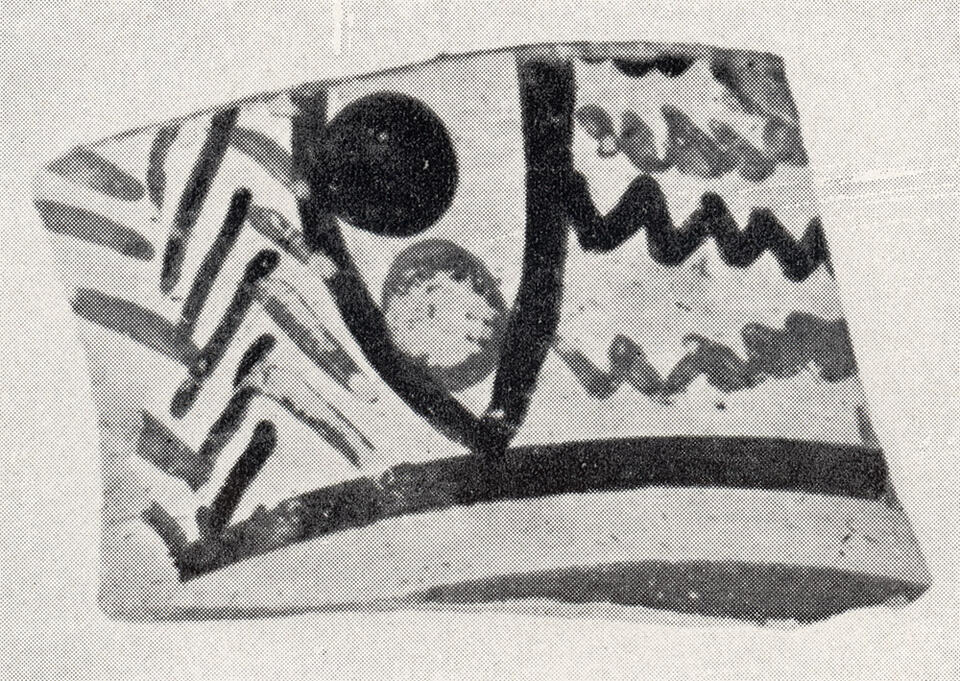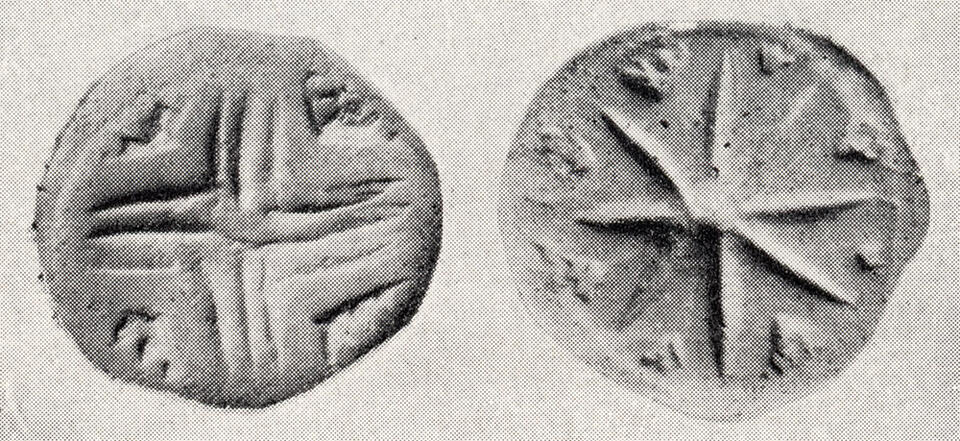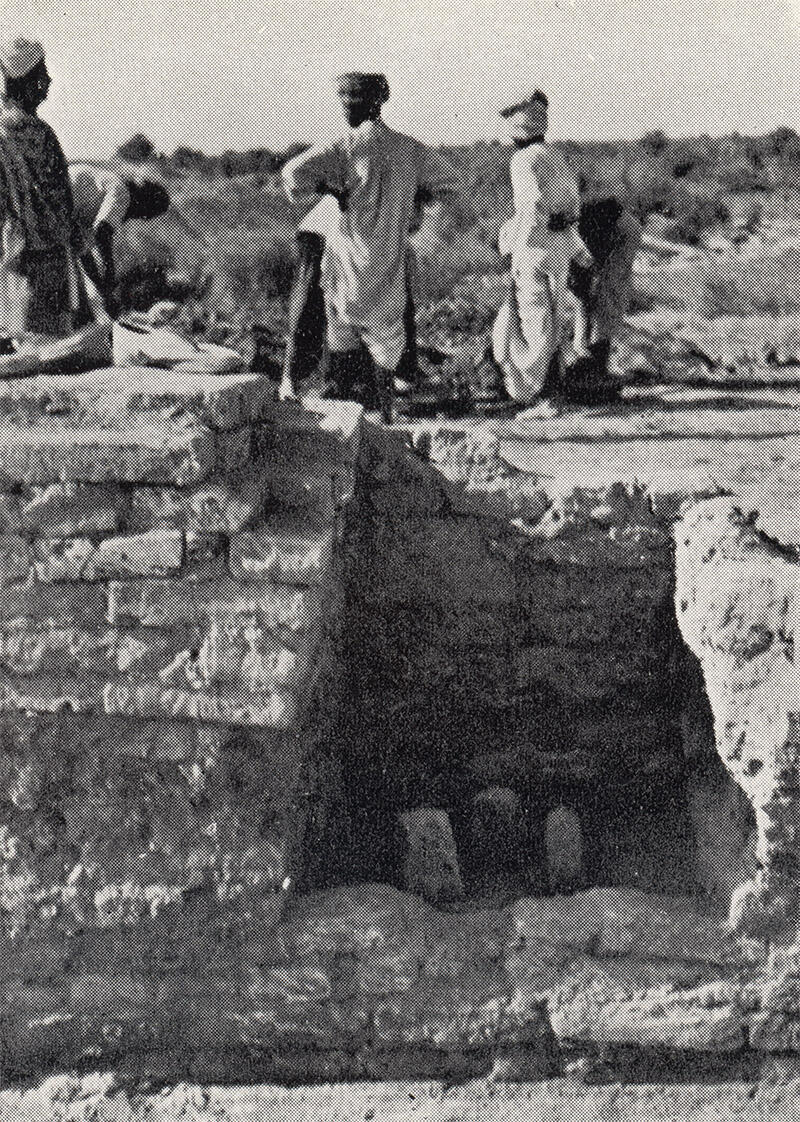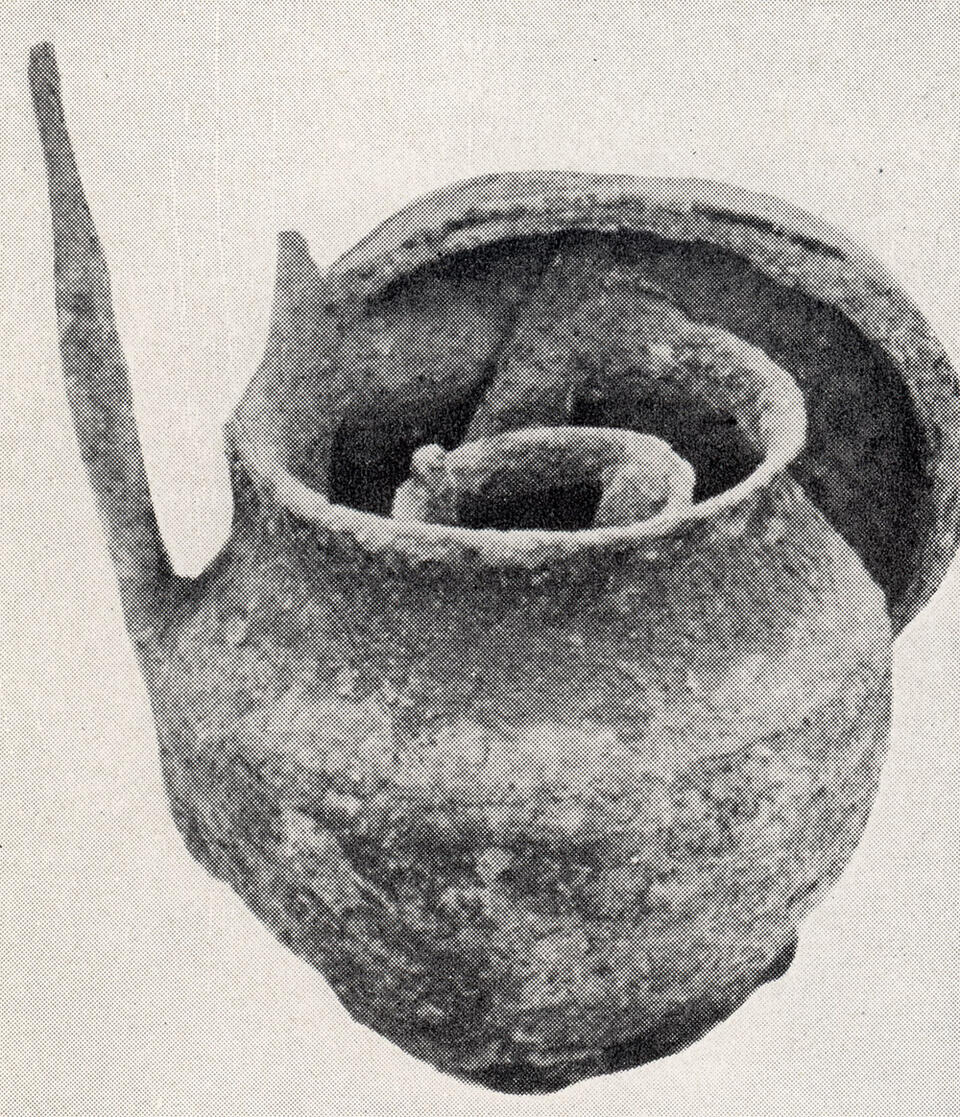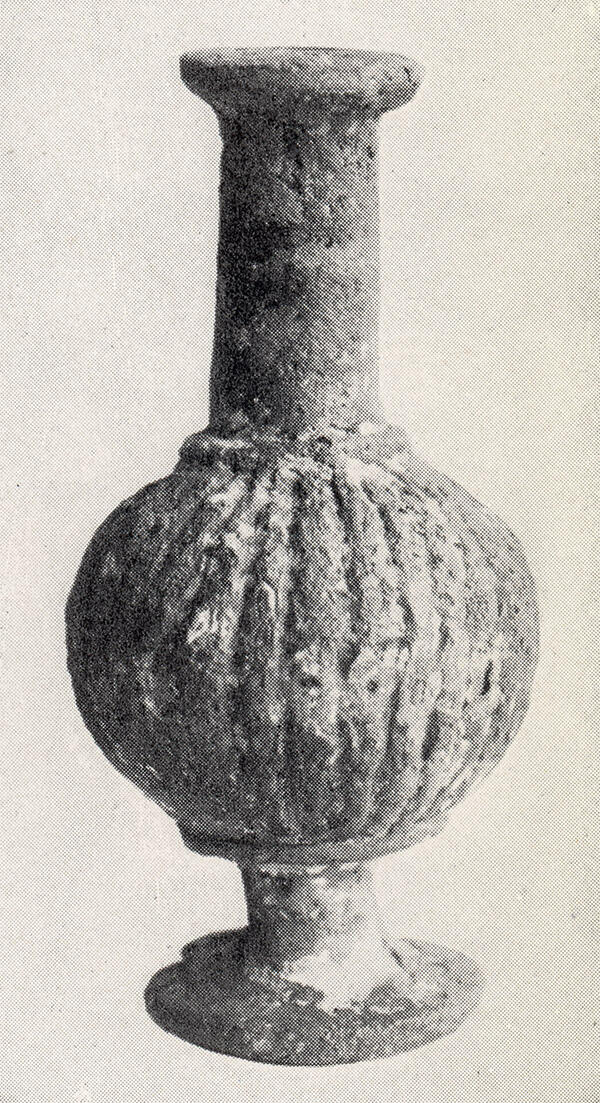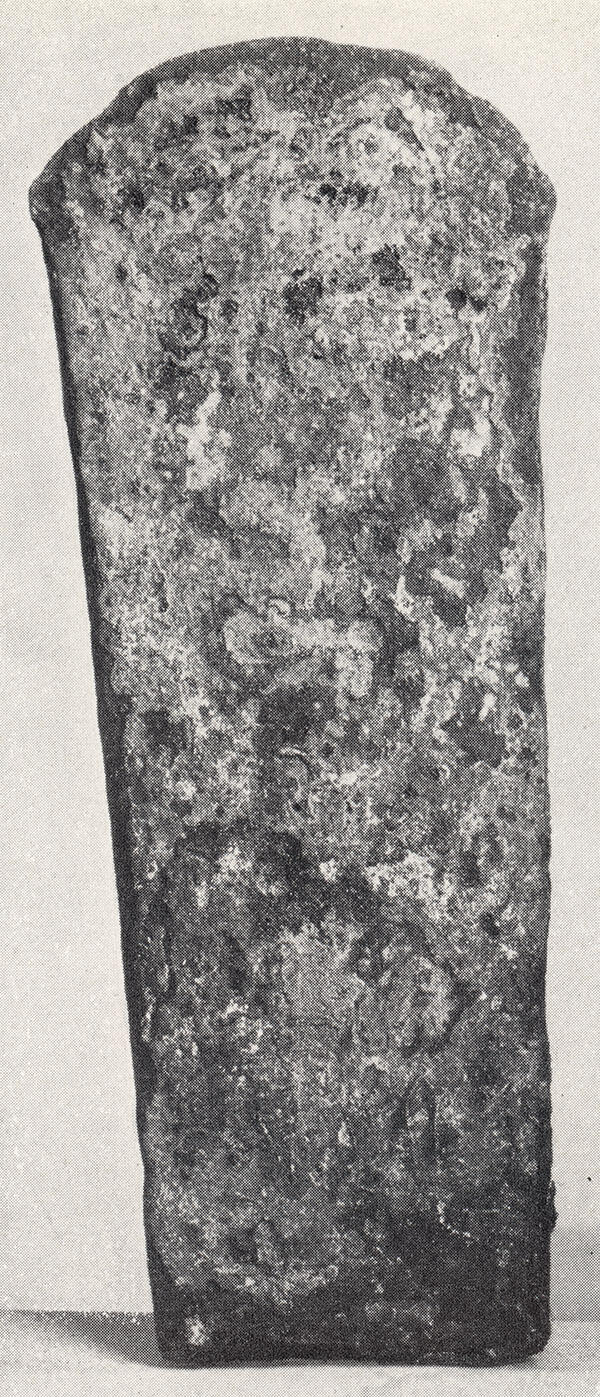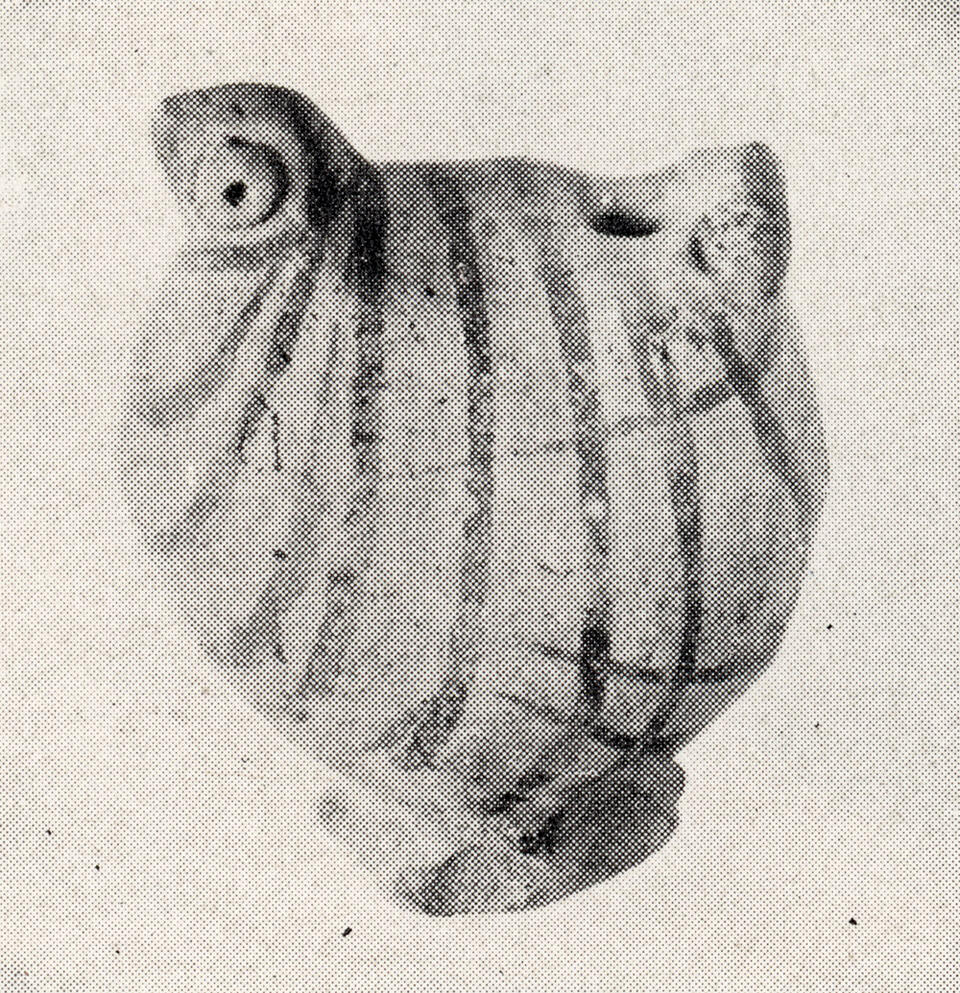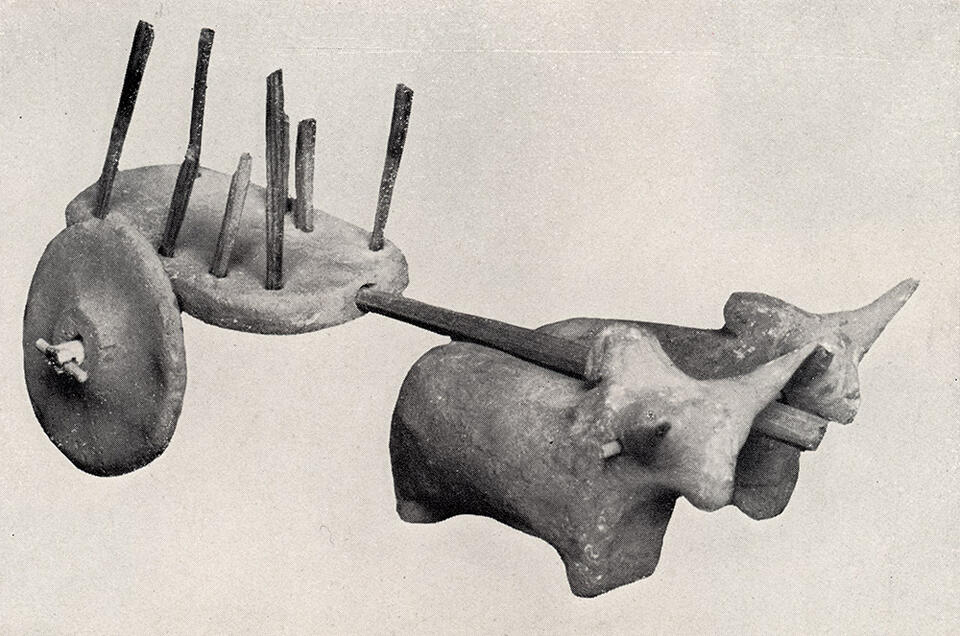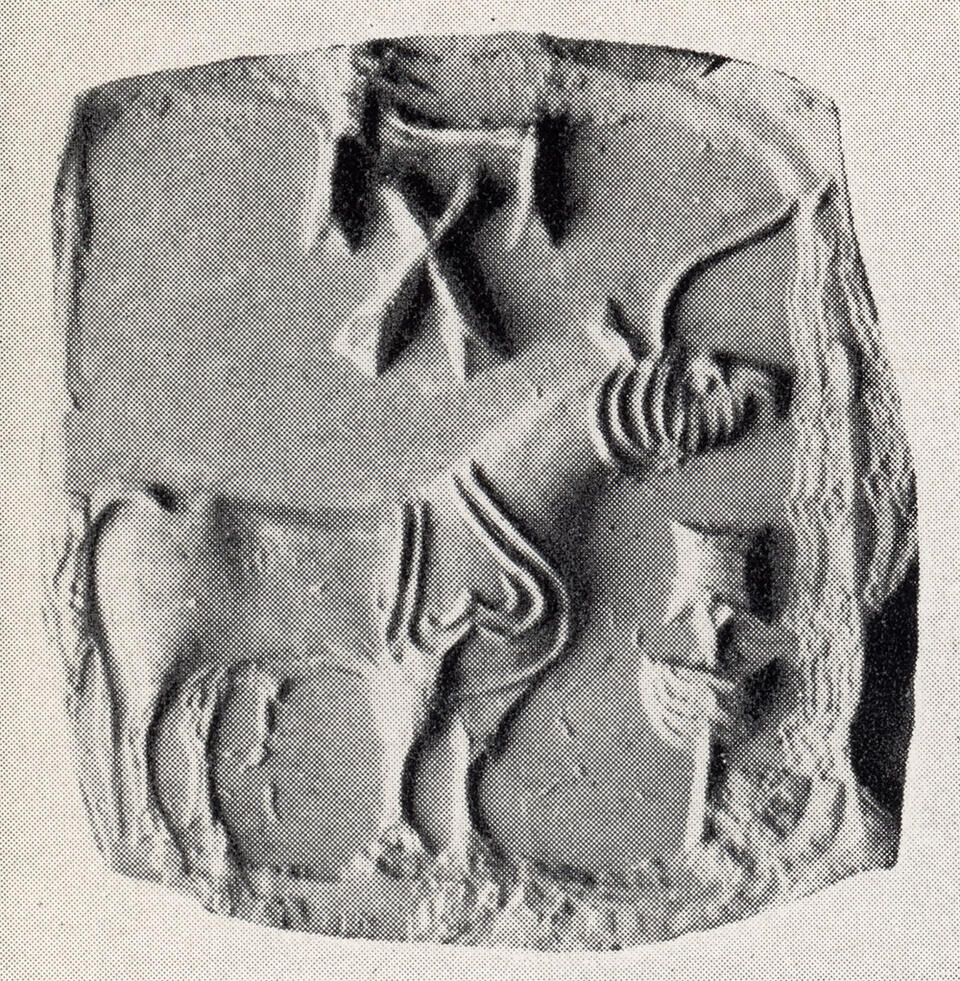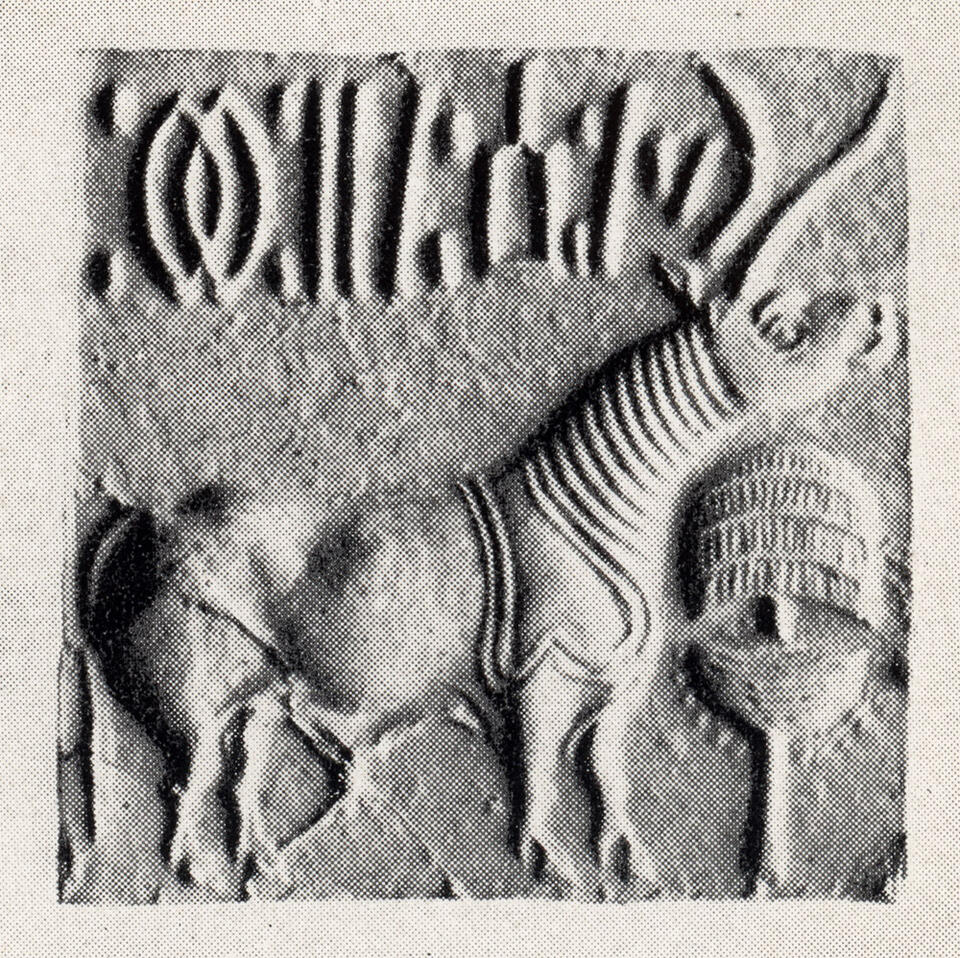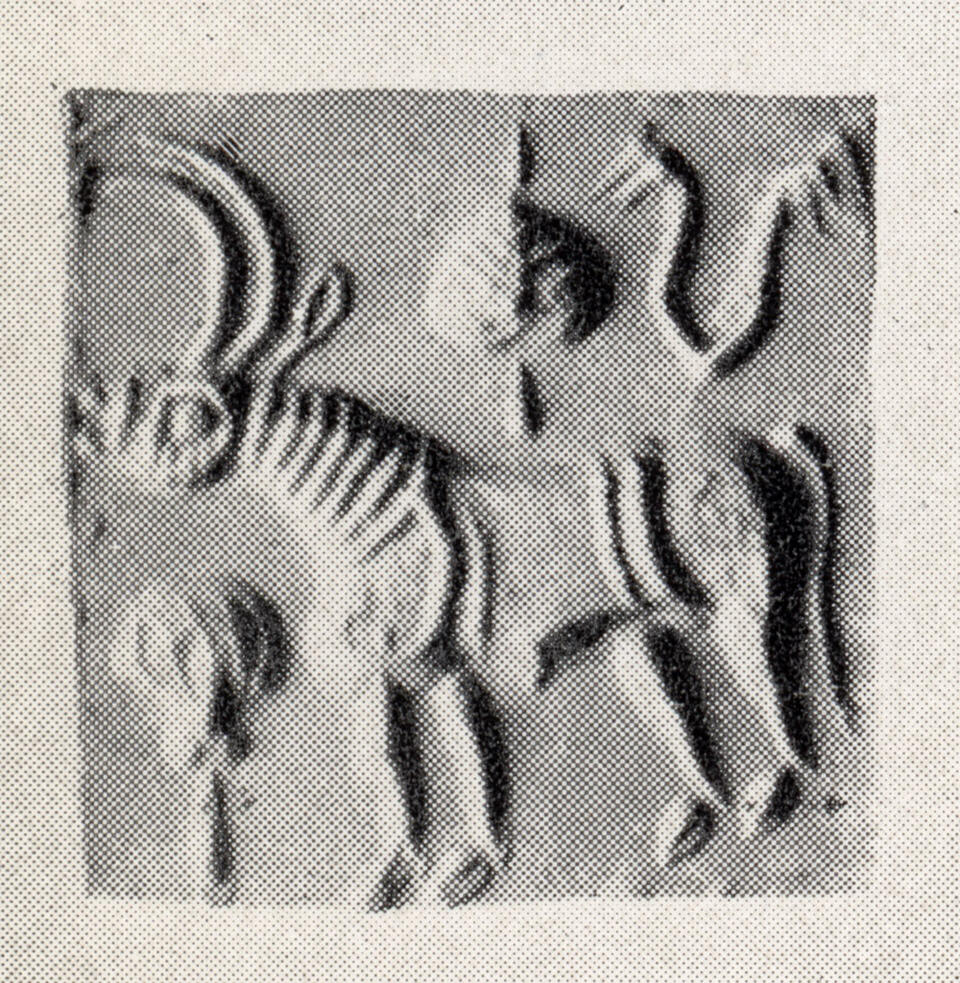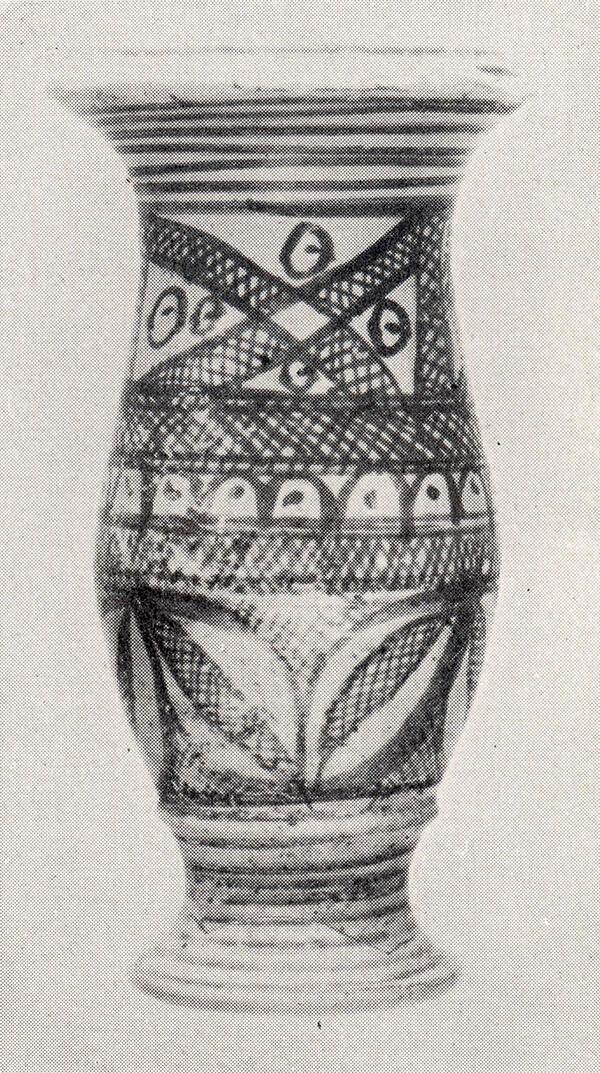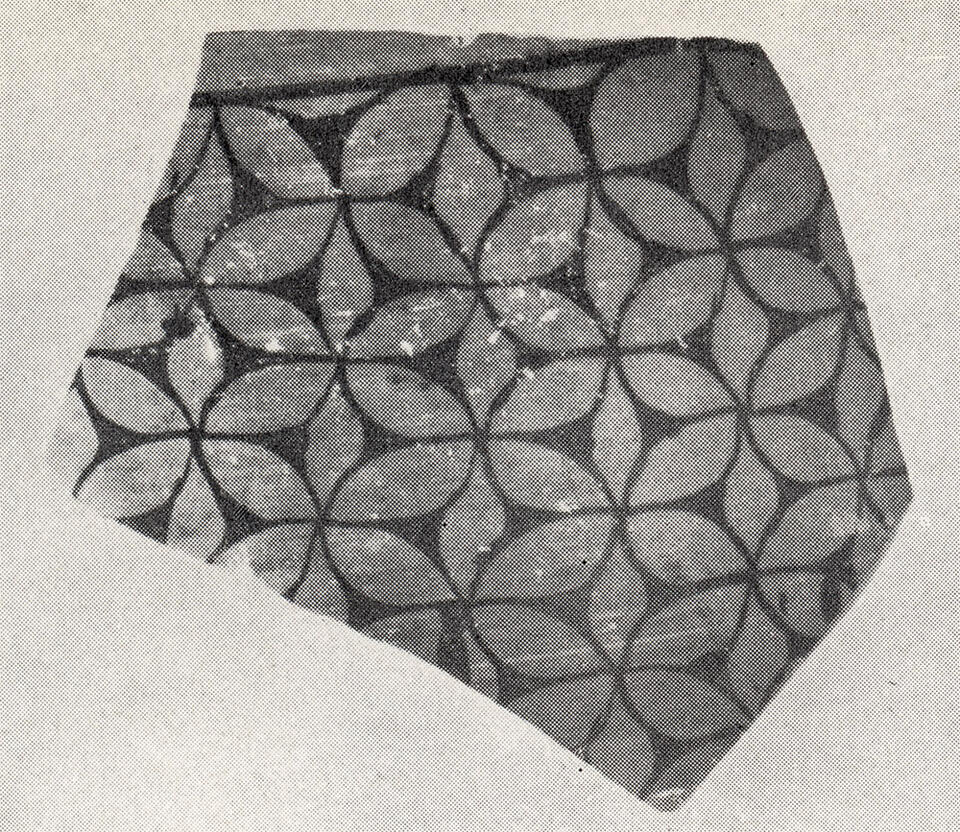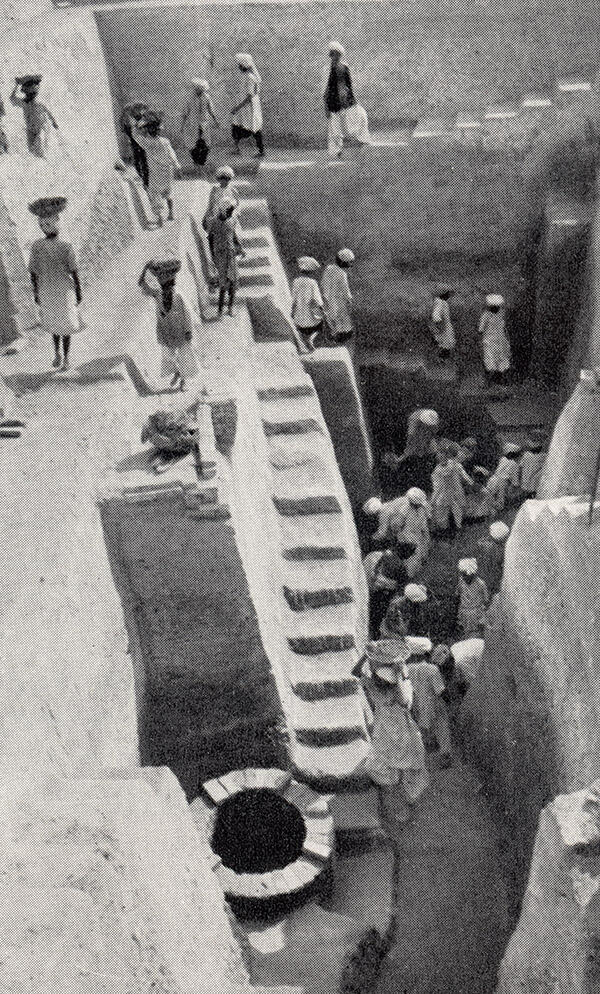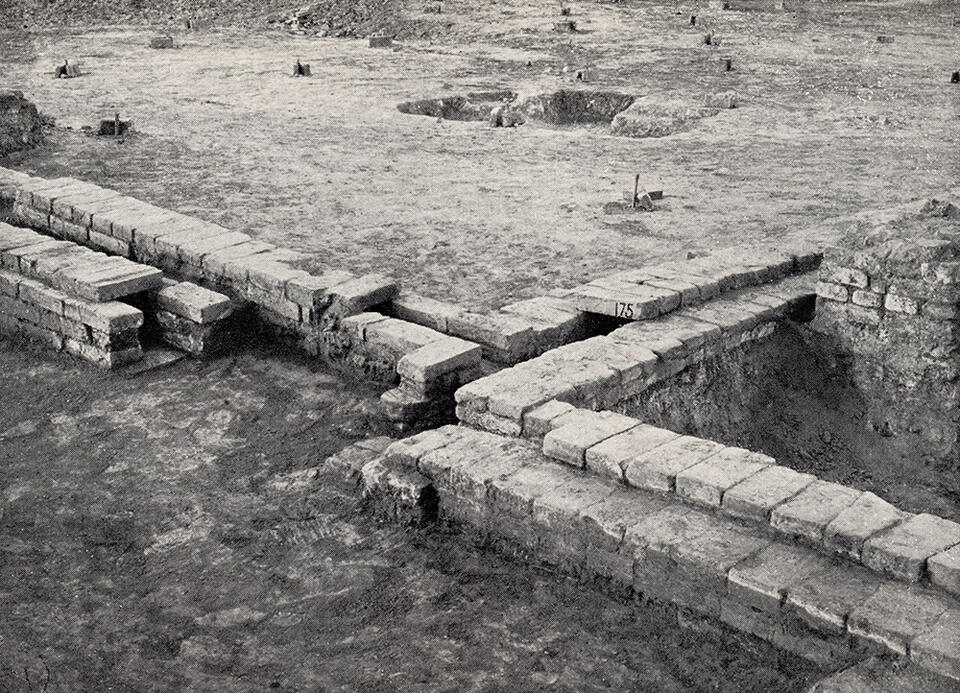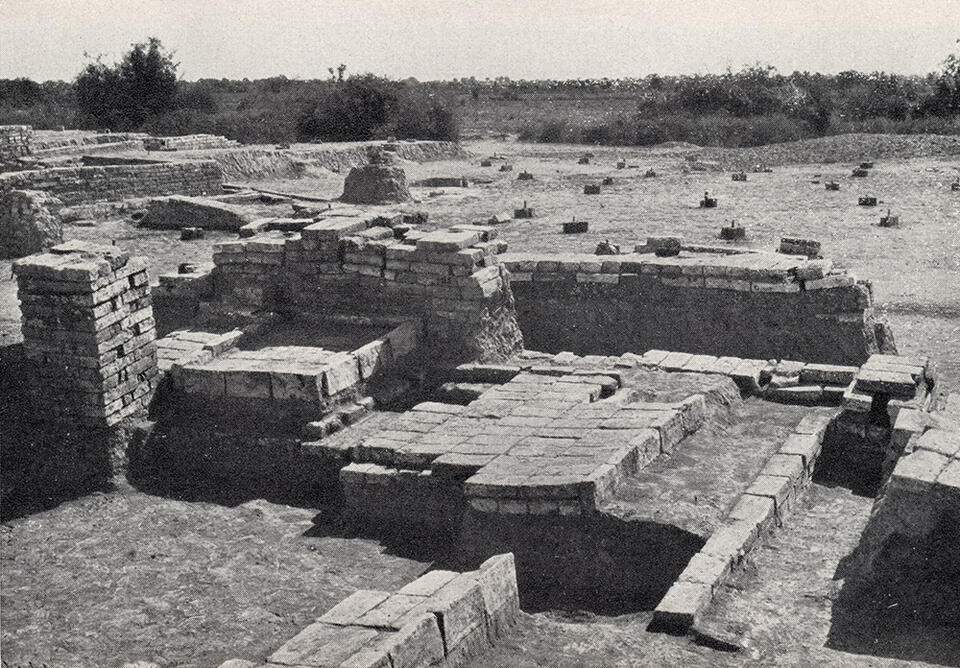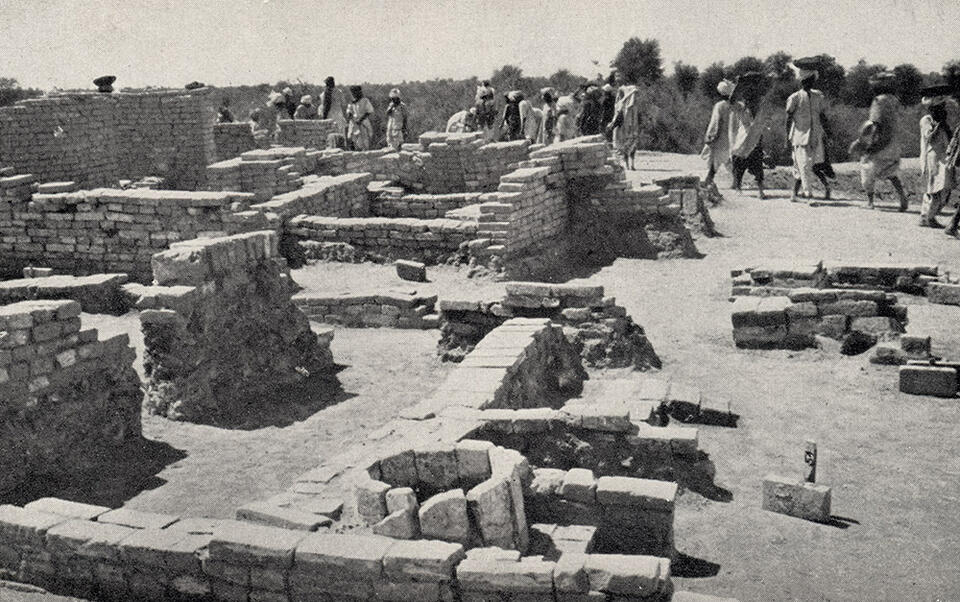EXCAVATIONS AT CHANHU-DARO BY THE AMERICAN SCHOOL OF INDIC AND IRANIAN STUDIES AND THE MUSEUM OF FINE ARTS, BOSTON:SEASON 1935-361
The Museum of Fine Arts, Boston, now possesses a remarkable and widely representative collection of objects from the ancient Indus Valley, the only such collection outside India. Not only is the culture of Harappa and Mohenjo-daro well represented at Chanhu-daro in the Nawabshah District of Sind (Fig. 1 [map]), the site at which this collection was unearthed, but there were also found the seal-amulets and pottery of a people who occupied the site fairly soon after it had been deserted by the Harappa people, objects which it will be seen differ radically from those left by their predecessors.
The mounds of Chanhu-daro were selected for the preliminary investigations of the first American archeological expedition to India on account of important finds made there during a survey of the ancient sites of Sind by the Archeological Department of the Government of India in the winter season 1929-30. Mr. N. G. Majumdar, who dug three trial trenches there, showed that Chanhu-daro had been occupied by the same race that built the cities of Mohenjo-daro and Harappa some 5,000 years ago. He also found some slight evidence of the presence of a later civilization which can now be named the “Jhukar culture”, in accordance with the convenient practice in Egypt and Mesopotamia of naming a culture after the site where traces of it were first found. The so-called Indus Valley civilization should be renamed the“Harappa culture”, for further excavations in the great river valley will undoubtedly reveal the remains of yet other ancient cultures.
Chanhu-daro is some 12 miles east of the present bed of the Indus, about 80 miles SSE. of Mohenjo-daro. Its three mounds comprise an area of 9 acres, but the little city was considerably more extensive in ancient times and the alluvium deposited in the course of 5,000 years or more now covers the lower parts of the mounds. Mound I is 22.2 feet high, and some 1,500 square feet in area, and the rather larger Mound II, 23.5 feet high and about 3,850 square feet in extent, is separated from it to the NE. by a gap some 150 feet wide. (pl.1) During the period of the Harappa culture, Mounds I and II were one, through which a devastating flood ultimately cut its way, bringing to a close the longest and most important chapter of the history of the little city. Mound II was reoccupied later for two brief periods, as we shall shortly see. The third mound (III), which stands a few feet high and is only some 500 square feet in extent, lies close to the NW. of Mound II, of which it is certain that it once formed a part; the rainstorms which have separated this little mound from its neighbor have left their marks as deep furrows and ravines which scar the sides of all three mounds.
As Mound II was the largest and highest mound and therefore likely to contain the most interesting material, it was selected for our principal excavations. Its upper portion was systematically removed, layer by layer, the debris being dumped on ground that had already been examined by means of trenching. On the summit of the mound were one or two graves of early Muhammedan date. Below these very late remains, a few pieces were found, mostly intact, of a very interesting dark gray, polished, hand-made ware with incised geometric decoration (pl. 2, fig. 1). The exact date of this ware is at present a matter of surmise, but in shape and technique it is entirely dlifferent from anything produced by the two cultures whose remains we found beneath it. I am inclined to think that this gray, hand-made pottery was made by a primitive people who were the last to occupy the site and that only very briefly and in small numbers – and who may have been a race allied to the Bhils, of whom there is a settlement close to Chanhu-daro; these Bhils, however, have lost most of their ancient customs and primitive way of living.
In the stratum below this gray ware we came upon a large quantity of wheel-made pottery, quite unlike the wares found either above or below it. This pottery which was mostly polychrome, with devices painted in black and red on a cream or pink slip, is represented mainly by broken fragments of the pans and stems of offering-stands, though pieces of other types of vessels also were found (pl. 2, fig. 2). Though polychrome pottery was made at the latter end of the Harappa period, the polychrome ware of the upper levels of Chanhu-daro in nowise resembles it in shape or style of decoration. Its presence in consider-able quantities therefore emphatically marks the occupation of the site by a different people. At Jhukar also, where Mr. Mazumdar first unearthed pottery of this kind, it was in a stratum that showed it to be of later date than the Harappa culture. A principal feature of this Jhukar ware is that broad horizontal bands of red separate the various devices that ornament it. Red was also used in combination with black for certain motifs, a common one being a chevron pattern of red and black alternately (pl. 2, fig. 3). The designs on the Jhukar pottery are either geometric or very conventionalized, boldly painted plant designs of leaves or buds joined together with curved stems. As a rule these plant designs were painted in black, or a deep purple, the red being used for the broad bands separating the registers, but occasionally the interiors of the buds or leaves, if not hatched (pl. 2, fig. 2), were colored red.
The only other known wares that the Jhukar pottery resembles-and only in the designs and use of colors, not in shape-are those found by Baron Max von Oppenheim at Tell Halaf in northern Assyria2 and by M. E. L. Mallowan at Tell Chagar Bazar.3 At both sites broad horizontal red bands were used to separate the registers, and the very distinctive chevron pattern in alternate red and black on a number of the Jhukar potsherds of Chanhu-daro is identical with the chevron design on the later Tell Halaf pottery. Other painted devices on these wares correspond very closely. Mr. Mallowan has postulated “a link which will bridge the gulf between the end of the Tell Halaf period and the pottery of India and Baluchistan,” and he suggests that the early potters of Assyria and Syria moved eastward. There seems no doubt that the pottery of the Jhukar culture had been influenced by the later wares of the Tell Halaf culture, and we must look to the Iranian Highlands for the region whence it was brought to India. The fact that the Tell Halaf pottery is considerably earlier in date than the Jhukar ware is no matter for concern; some time had necessarily to elapse before an influence from Syria could have had effect in northwest India, and many long halts were doubtless made before the end of the journey. The people who introduced the Jhukar culture into the Indus valley appear to have left but few traces in Baluchistan; but a great deal of systematic excavation needs to be done in that country, for one notable sherd with red and black chevrons found by Sir Aurel Stein at Zayak might equally well have come from the Habur region or from India.4 The presence on some of the pottery of ancient Baluchistan of wide red lines between the registers is a feature shared both with the north Mesopotamian pottery of Tell Halaf and the Jhukar ware of the Indus valley.
There is a considerable body of evidence that the people of this Jhukar culture occupied the principal mound at Chanhu-daro comparatively soon after its desertion by the people of the Harappa culture, and I would date this occupation to about 2000 B.C. It was only a small settlement and, judging from the number of rough pavements and fireplaces found, the people lived in houses of matting, all other traces of which had disappeared. The head-man had a plain, roughly built house of bricks, taken either from the lower part of the mound or from other buildings of the Harappa culture in the vicinity. One very interesting feature in a room of his house was a fireplace in a recess in the wall with three bricks still in it which served to support a cooking vessel (pl. 3, fig.1).
Not only does their pottery, of which a surprising amount was made and used, distinguish these people from their predecessors of the Harappa culture, but they wore seal-amulets, mostly pottery, which in their shapes and ornamentation are totally unlike the square and rectangular seal-amulets of the Harappa culture. Some are round stamp seals with roughly shaped perforated handles at the back, and others lentoid with designs on both faces and perforated laterally (pl. 2, fig. 4). These Jhukar amulets are with one or two exceptions very roughly made, and none bears any inscription; in fact, we are as yet uncertain whether their owners knew how to write. Many of them resemble certain seal-amulets of early Elamite date, and one exceptionally well made lentoid amulet with an endless rope pattern on one side recalls both in shape and the design certain Hittite seals; which is the less surprising when we consider the marked affinities of the pottery with the late ware of Tell Halaf.
A number of bone awls polished by much use suggests that the Jhukar people made baskets, and judging from the number of bobbin-shaped objects that they left they seem also to have been workers in textiles. The figurines of the Harappa levels tell us that the head-dresses of that period were very elaborate, and this appears to have been the case in the Jhukar period also; a very fine headrest of painted pottery was undoubtedly intended to protect the headdress of its owner from damage during sleep.
Close beneath the Jhukar stratum we came upon buildings of the Harappa culture at a level approximately 13 feet below the summit of the mound. Here were found the remains of burnt brick houses with the bathrooms, drains, and other conveniences now well known at Mohenjo-daro and Harappa. Here, too, were found the copper and bronze implements and tools that now form an important part of the collection in the Museum. Two hoards of these implements were so corroded together that it was not until the end of the season when they could be chemically cleaned and separated that we became aware of what we had found (pl. 3, fig. 2). Blade axes (pl. 4, fig. 1), chisels, spear heads, and copper and bronze vessels of various shapes, all go to show that Chanhu-daro was a great center of metal working; but whether bronze or copper was the metal more commonly worked can only be ascertained by analysis of the material obtained.5 Considerable skill in the working and casting of bronze is shown in the cosmetic jar (pl. 3, fig. 3), and especially in the toy cart with a pent roof. The latter shows us a type of vehicle that was in common use at the time, for a very similar little model has been found at Harappa, well over 400 miles away to the NE.6
Important evidence of metallurgical practice was the number of small masses of lead that were found, evidently the remains of some considerable working in this metal. These fragments of lead are now being examined for their silver content, but it may be that any silver that existed was extracted before the lead reached Chanhu-daro.
No skeletal remains of either the Jhukar people or Harappa people were found, save a skull that had been placed in a large storage jar together with a small collection of metal objects and a large conch shell.Some care must have been exercised in inserting this skull in the jar, whose opening was barely wide enough to receive it; and why the skull only was thus carefully preserved and not the other bones is a matter for speculation.
Bead making was practiced even more extensively at Chanhu-daro than metal working. The long agate and carnelian beads of barrel-cylinder shape, of which so many fine specimens were found at Mohenjo-daro, were quite possibly made at Chanhu-daro, for large numbers of them were unearthed in all the various stages of making. The long rectangular slips of stone struck from the parent nodule were first flaked roughly into shape, then, after careful chipping to remove the angles, thèy were ground into the required cylindrical form by rubbing on a piece of sandstone, which became deeply grooved in consequence. The beads were bored from both ends with a stone drill, and they finally received a polish that shows the craftsmen of Chanhu-daro to have had long experience in the art of working hard stones. The stone drills that were used, of which a number were found, both whole and broken, are a new discovery; it has hitherto been supposed that in ancient times stone beads were bored by means of a copper drill with the aid of an abrasive. These stone drills, of chert, must themselves have taken considerable time and labor to shape, and as their hardness is about the same as that of the stones used for bead making an abrasive must have been used with them; but whether the latter was emery or some other material we have yet to discover.
Beads were also made of softer materials such as steatite; a number of tubular shape, stuck together by the salty soil and evidently once contained in a fine basket which had perished, would, if placed together end to end, run 35 to 40 to the inch. How they were shaped and, even more, how they were bored is at present quite incomprehensible.
Save in their extraordinarily skillful bead-making and also in the manufacture of weights-a subsidiary industry-the people of Chanhu-daro made little use of stone for other purposes. Copper was evi-dently so plentiful that stone implements had already been practically discarded. Ribbon-flakes struck from a core of coarse chert were, however, doubtless used as kitchen knives: they were found in many of the houses, together with the cores from which they were struck, and it is evident that the housewife provided herself with simple knives as easily as she discarded them when blunt.
Stone was occasionally used for mace-heads, both of globular and lentoid shape, for drill-caps, and even for dishes; the latter, however, were both few in number and very clumsily made. They were, moreover, sometimes made of a soft form of alabaster, a stone which does not withstand corrosion by salt. A large number of rectangular stone palettes with smooth level surfaces were found, but the great majority were broken. They were probably used for preparing cosmetics and may have been placed on the small, roughly made pottery toilet tables with four short legs, which also were rarely found intact.
A remarkable number of toys were found at Chanhu-daro, far too many, it would appear, to have supplied the wants of the child popula-tion there; it is possible that toy-making also was a local industry. Toy vehicles of various shapes made of pottery, mounted on two or four wheels and drawn by a pair of humped oxen as in modern Sind, form an interesting feature of the collection in the Museum (pl. 5). Pottery model rams, with the fleece indicated by lines of red paint and mounted on two wheels with a hole through the neck for a draw-string, were common playthings. Marbles of pottery and stone, whistles ovoid or shaped like hens (pl. 4, fig. 2), and brightly colored rattles for the younger children were abundant. The better made playthings in the Museum collection are undoubtedly the work of professional toy makers; but the children also made toys for themselves in mud, and baked them in holes in the ground covered with fuel.
A number of pottery figurines were found of the Mother-goddess, who was also worshipped at other centers of the Harappa culture. Some of these figurines wear a curious fan-shaped headdress ornamented with bands of material, unless it is strands of hair that are represented, carried over a support of some kind. The nose was simply pinched up by finger and thumb, and in the depressions thus formed pellets of clay were set to represent the eyes. Possibly there was one of these little figures in every house in a niche in the wall; and with them there seem to have been associated the little model doves with outstretched wings, each with a hole in the base to set it on a wooden pin. As we know that the dove was intimately connected with the worship of the Mother-goddess in ancient Crete, Sardinia, Mesopotamia, and elsewhere, it seems likely that it was in the Indus valley also. These bird figures were most probably votive offerings, placed in or upon the shrine of the Great Mother in fulfillment of a vow or in the hope of favors to come.
The seals-or rather seal-amulets, for they undoubtedly served both purposes-were all made of steatite. In shape, material, and the animals engraved upon them, they are identical with those found at Mohenjo-daro and Harappa, and many of them were similarly given a smooth white surface to enhance their appearance. The animal most often represented on these seal-amulets is an oxlike beast always in profile with a single horn (pl. 6, fig. 1). This creature has been identified with the urus-ox, a beast which is extinct in most parts of the world. Before it there is always placed a curious upright object, which on the better carved seals is seen to have been made of wickerwork (pl. 6, fig. 2). What this object really was is as yet uncertain. It has been identified as a fodder-rack, a cage for a bird, and an altar. That it was a cult-object is, however, certain, for at Mohenjo-daro and Harappa amulets have been found on which this object is carried on a staff in what was obviously a religious procession. This oxlike animal with its cult object is much the most common device on the seals of the Harappa culture, but there are other animals also on the seals. The collection in the Museum includes an elephant, an antelope (?) (pl. 6, fig. 3), and a short-horned bull, which animal was always represented with its head lowered over a manger. The pictographic script above the animals has still to be deciphered, and of this there seems little prospect until a bilingual inscription has been found. We have great hopes that such an inscription may be found at Chanhu-daro, or, it may be, in Mesopotamia, for we have undoubted proof that the people of Harappa culture traded with Mesopotamia: objects obviously made in that country have been unearthed at Harappa and Mohenjo-daro and a considerable number of seals like those in our collection, and obviously of Indian workmanship, have been found in the Sumerian cities.
These seal-amulets were mostly carried on the person as amulets, but that they were also used as seals is shown by a seal-impression, which has on the back the marks of attachment to something, probably a bale of goods. Another seal-impression, which had been carried about a long time and so had been badly rubbed, shows two women supporting a staff between them from whose top project the branches of a pipal tree. This tree is still sacred in many parts of India.
The pottery of the Harappa culture is easily distinguishable from the wares of the Jhukar culture found above it. The designs painted in dense black on a highly burnished red slip distinguished it from any other pottery found in ancient India (pl. 6, fig. 4). A very common motif is based on a series of intersecting circles, on some of the sherds hardly recognizable, but on others so finely painted as to be almost mathematical (pl. 7, fig. 1). This motif was used on both large and small jars and is peculiar to the Harappa culture.
Another motif often used at Chanhu-daro, but rarely at Mohenjo-daro, is a scene of peacocks en file, drawn in a very sketchy way but nevertheless quite recognizable. This design was very generally used on the large jars, probably used for storing water, fragments of which were found all over Mound II. These jars were carried in rope slings suspended from the shoulders of the water carrier, and on this account the designs had often been partially worn away by the friction of the sling. Even quite small vessels were ornamented with paint, even if only with a few bands of red round the shoulder.
Certain small pottery vessels, all very much the same size and shape, seem to have been supplied by shopkeepers to purchasers of small quantities of cooking oil and the like, as at the present day. Other small jars with extraordinarily narrow mouths once contained an eye paint, which cosmetic was apparently used by men and women alike. Of particular importance is the bronze cosmetic jar with fluted sides, which is a notable feature of the Museum collection (pl. 3, fig. 3). Here might be mentioned a rectangular slip of red ochre with a beveled end, whose shape makes it more than likely that is was used as a face paint, if not actually as lipstick.
The small cones of pottery or shell which were found in the Harappa levels at Chanhu-daro are somewhat of an enigma. Very similar cones served an architectural purpose at Warka, Ur, and other early Sumerian sites, but insufficient numbers have been found at the Indian sites to warrant the assumption that they were put to a like use. They may have been cult objects, or even skittles to be knocked over with marbles; I am inclined to regard them as the former, for they appear among the motifs on some of the painted pottery.
A large number of chert weights, carefully made and polished, form part of the Museum collection. They are nearly always cubical, and they belong to a definite system, with the simple ratios 1, 2,4,8, etc. In weight they vary remarkably little from those found at Mohenjo-daro, and similar weights from Harappa, more than 400 miles NE. of Chanhu-daro, have the same actual weights according to their respective sizes, proof that the authorities of those days exercised strict supervision over this very necessary adjunct of trade. Indeed, it is probable that some of the more carefully finished weights exhibited in the Museum were master weights by which others could be tested and rectified.
In the uppermost level of the Harappa culture there were but few intact buildings, though relics of houses and an extensive drainage system were found in this stratum all over Mound II. The occupation level below was in a better state of preservation, and streets and lanes, each with its houses and drains, were more or less intact and could be satisfactorily planned. Remains of a still earlier occupation were revealed in the upper part of a large cutting that was made in the western side of the mound to test the strata below (pl. 7, fig. 2), and at still lower levels were found traces of other occupations until the subsoil water prohibited any further digging. One very striking feature of these occupation levels in Mound II was that each was separated from those below and above by a considerable lapse of time. At Mohenjo-daro one occupation followed on another in swift succession, the later builders simply using the walls of their predecessors as foundations, thus preserving the alignment of the streets and houses over a very long period. At Chanhu-daro quite a considerable amount of debris separated the two uppermost Harappa occupations, and the buildings in the stratum next below these two were orientated quite differently from those above them. Indeed, we found ample evidence that it was destructive floods that caused the city to be deserted for considerable periods of time, during which large quantities of bricks were removed to build elsewhere. The walls of the three upper occupations of the Harappa culture had in some cases been so undermined by flood water, and tilted by the consequent subsidence, that we had to remove the upper parts to avoid risk of their falling on our workers. Even the brick flooring of rooms had subsided here and there. We at first thought that this irregularity of the walls was due to earthquake; but, had that been so, the rooms would have contained fallen bricks. At least three floods, the third of which was perhaps the great flood that led to the desertion of Mohenjo-daro, have left their traces at Chanhu-daro. Living on the Danlks of a great river running through an alluvial plain must hare proved even more disconcerting in ancient times than it does today in many parts of the world.
The bricks used at Chanhu-daro were very much the same size as those of the other Indus cities; they average 11 by 5/2 by 2/2 inches. Made of well-fired clay, they are well-shaped but have no frogging of any kind. The mud mortar used amply served its purpose. They were laid to dry as they were shaped in open molds, and occasionally one is found with the impress of an animal's foot. For special purposes,such as lining wells,wedge-shaped bricks were made, and angle-bricks and half-sized bricks have been found. Bricks were also cut into various forms after being laid, as in the recesses of water-chutes; and those forming the corners at the junctions of drainage channels were often carefully rounded off with a chisel so as to impede the flow of water as little as possible (pl. 8). Most of the drains were made of ordinary bricks, and they were laid only a few inches below the surface of the ground so that they might be got at easily for cleaning. Owing to the demolition of many of the houses for the sake of their bricks, whenever the site was deserted, few of the bathrooms were found intact. Those few were simple platforms, of carefully laid bricks edged all round to a height of some 2 inches with bricks laid on edge; the water flowed away through an opening that sometimes communicated with a latrine situated between the bath and the street wall, and thence through an aperture in which the effluents passed to the street drain outside (pl. 9). There is no doubt that the sanitary system of the ancient Indus cities surpassed any other of contemporary date, and it is quite safe to say that it was superior to that in many modern oriental cities, which civilization seems barely to touch.
After the partial leveling of Mound II, a trial excavation was commenced on the summit of Mound I (pl. 10). Here several buildings were laid bare, also of the Harappa culture, but slightly later in date than those in Mound II. It seems that Mound I was occupied by the people of that culture later than was Mound II. Here,too, a few sherds of the Jhukar culture were found in the uppermost part of the mound, but so few that it seems that the Jhukar people only visited and never actually lived on the mound. Mound I offers scope for considerable and profitable investigation, and there is reason to think that it will prove even more productive of museum objects than the fortunate finds in Mound II which have so greatly widened the horizon of our knowledge. The discoveries of a new phase of Indian history with far-flung cultural connections, and metal objects of types never found before, together with fresh insight into the various arts and crafts of a great civilization that 20 years ago was unknown and unsuspected; such are the results of one small season's work of America's first archeological expedition to India.
1. Reprinted by permission from the Bulletin of the Museum of Fine Arts, vol. 34, no. 205, Boston,October 1936.↩
2. For a popular account see Baron Max von Oppenheim, Tell Halaf.↩
3. Iraq., vol.3, pt.1,1936.↩
4. Gedrosia, p. 33, pl. 1, z. n. 7.↩
5. At Mohenjo-daro, bronze was nearly as common as copper, even in the lowest levels.↩
6. Ann. Rept. Arch. Surv. India, 1926-27, pl. 23, d.↩


